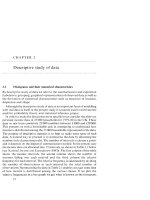Study of field emission characteristics of ultrathin film coated carbon nanotubes core shell structures 4
Bạn đang xem bản rút gọn của tài liệu. Xem và tải ngay bản đầy đủ của tài liệu tại đây (3.7 MB, 21 trang )
Chapter 4 Synthesis of Vertically-Aligned Carbon Nanotubes
51
Chapter 4
Synthesis of Vertically-Aligned Carbon
Nanotubes
This chapter focuses on the synthesis of carbon nanotubes (CNTs) used as substrate
for the following thin film deposition. The CNTs are required to be highly densed and
vertically-aligned to be suitable for field emission (FE) application. Therefore,
plasma-enhanced chemical vapor deposition (PECVD) technique has been employed
for CNT growth with Fe acting as catalyst. SEM and TEM were utilized to
characterize the as-grown CNTs. The growth mechanism of the CNTs and the
function of the metal catalyst will be discussed. The growth rate of the CNTs will be
investigated as well.
4.1 Introduction
Synthesis of CNTs has been extensively studied since their discovery [1-5]. Arc
discharge approach was used when Iijima first reported the synthesis of CNTs, which
is similar with the method used for traditional fullerene preparation. After that, several
methods have been explored to produce CNTs, including CVD, laser ablation and
some other approaches such as solar energy, electrolysis, underwater alternating
current electric arc method and plasma torch method [6-8].
Chapter 4 Synthesis of Vertically-Aligned Carbon Nanotubes
52
Essentially, all of the CNTs are formed in the same way but the process which
causes the formation differs. In both the arc discharge and laser ablation, a solid
graphite carbon is heated to a very high temperature, leading to the separation of some
carbon atoms from the solid. These atoms then reassemble on the cathode in the case
of arc discharge and on a cooled collector in the case of laser ablation. During the
reassembly process, carbon is arranged in the tubular formation on a nanoscale level.
In these fabrication methods, no catalyst is involved.
Alternatively, catalyst has been used in the growth of CNTs. The catalytic CVD
growth of CNTs is an entirely different process with the arc discharge and laser
vaporization methods. Instead of beginning with a solid carbon, the carbon atoms are
extracted from a carbon monoxide or hydrocarbon gas, which dissociates either
thermally or in the presence of plasma. Subsequently, the dissociated carbon atoms
once again self-assemble into highly ordered nanotubes. However, in this case, the
nanotubes form on a prepared substrate with small catalyst particles on it. The
nanosized catalyst particles act as seeds for nanotube growth. Therefore, the size of
the catalyst particles determines the size of the as-grown CNTs, as well as their
locations [4]. The advantages of the catalytic growth of CNTs are that long nanotubes
can be achieved at relatively low temperatures [9]. However, this kind of CNTs is
rather thick with their diameters correlated to the sizes of the metal catalyst particles
and the graphene layers of the catalytic produced CNTs usually contain defects. The
CNTs are also covered with amorphous carbon, which is the product of the thermal
deposition of hydrocarbon [3].
Chapter 4 Synthesis of Vertically-Aligned Carbon Nanotubes
53
In terms of other CNT growth approaches, solar energy method means that
concentrated sunlight from a solar furnace is focused on a graphite sample in order to
vaporize the carbon. Afterward, the soot containing CNTs is condensed in a dark zone
of a reactor, which is collected in a filter and water cooled. Electrolysis method
fabricates CNTs via passing an electric current in a molten ionic salt between graphite
electrodes. Underwater alternating current electric arc method combines the
underwater growth with the application of an alternating current controlled power
supply [2, 6-8]. Some of these methods are innovative and effective in CNT growth.
However, the main problem of these methods is the incapability of producing
vertically-aligned CNTs. Although these CNTs are usually grouped into bundles, the
bundles themselves are not generally aligned with each other. The random orientation
of CNTs has impeded their application in some areas such as microelectronic devices
and field emission.
In order to obtain vertically-aligned CNTs, one method considered is the growth
of CNTs by plasma-enhanced chemical vapor deposition (PECVD) technique. There
are some advantages of growing CNTs by PECVD technique: [4]
(1) Dissociation of hydrocarbon gas and formation of CNTs take place at lower
temperatures (typically 600 - 700 °C) because the energy in the plasma discharge
replaces some of the heat energy;
(2) Vertically-aligned CNTs can be obtained due to the existence of electric field
during growth process;
(3) This technique is simple, cheap, high yield, and capable of producing large
Chapter 4 Synthesis of Vertically-Aligned Carbon Nanotubes
54
dimensional CNT substrates.
These advantages make PECVD a broadly used technique for CNTs preparation
reported by considerate studies [10-13]. In this research, we intended to investigate
the FE properties of CNT-based materials. Vertically-aligned one-dimensional
nanostructures are one of the most favored geometries for FE application. Therefore,
PECVD technique was employed to grow CNTs.
4.2 Experimental Details
Before growing CNTs in PECVD system, a layer of Fe catalyst was deposited on
the substrate. A RF (13.65 MHz) magnetron sputtering system with the model of
Denton Discovery-18 was applied to deposit the catalyst layers. First, a clean N++
silicon (100) wafer was cut with diamond cutter into small specimens with dimension
of around 5 mm × 5 mm. These small specimens were then placed as a circle on the
sample holder in the sputtering chamber, which was pumped down to ~10
-3
Torr by a
mechanical pump (rotary pump) and further down to ~10
-6
Torr by a turbo bump.
When the vacuum pressure was ready, these specimens were deposited for 3 min with
the RF power at constant 100 W. In the sputtering process, the chamber pressure was set
to be 0.01 Torr. The sputtering rate was calibrated by a surface profiler to control the
thickness of the catalyst layers.
After catalyst deposition, these substrates were transferred in air to the PECVD
chamber for CNT growth. Fig. 4.1 shows the schematic setup of the PECVD system
Chapter 4 Synthesis of Vertically-Aligned Carbon Nanotubes
55
utilized in this research. The chamber was pumped down to ~10
-5
Torr and the
substrate holder was heated up to 700 °C. Subsequently, H
2
gas with a flow rate of 60
sccm (standard cubic centimeters per minute) was introduced into the chamber to start
the H
2
plasma and lasted for 10 min in order to promote the formation of catalyst
nanoparticles. After that, C
2
H
2
with the flow rate of 15 sccm was introduced into the
chamber as the hydrocarbon gas. Growth durations varied from 3 min to 20 min in
order to obtain the most suitable CNT length. In the growth process, RF power was set
to be 100 W and the chamber pressure was approximately kept at 1.2 Torr. The
substrate temperature was measured by attaching a thermocouple directly to the
graphite substrate heater.
Fig. 4.1 Schematic setup of the PECVD system used.
Chapter 4 Synthesis of Vertically-Aligned Carbon Nanotubes
56
4.3 Results and Discussion
4.3.1 Characterization of the As-Grown Carbon
Nanotubes
Fig. 4.2 shows the macrograph of the as-grown CNT samples, which appear to
be dark and soot like. The SEM images of the high density and vertically-aligned
CNTs are shown in Fig. 4.3. The Fe catalyst layer was approximately 7 nm thick with
3 min sputtering duration measured by the surface profiler. From the low
magnification top view SEM image in Fig. 4.3(a) it can be observed that the CNTs are
highly densed on the substrate, confirming a high yield of CNTs by this growth
method. Under high magnification top view SEM image as shown in Fig. 4.3(b),
some small particles were observed at the top of the CNTs, which were speculated to be
Fe particles. Fig. 4.3(c) shows that the CNTs are both uniform in length and diameter.
From this cross-sectional view, it is clear that the CNTs are well-aligned with
Fig. 4.2 The macrograph of the as-grown CNT samples.
Chapter 4 Synthesis of Vertically-Aligned Carbon Nanotubes
57
Fig. 4.3 (a) Low magnification and (b) high magnification top view and (c) cross-section
SEM images of CNT samples obtained with Fe catalyst.
respect to the silicon substrate, and the nanotubes do not appear as thick hard rods but
seem to be like free-standing spaghetti. In addition, some CNTs at the edge do not
appear to be vertically-aligned in this image. The non-alignment is highly likely due
to the external force used to break the sample in order to capture the cross-sectional
SEM image of the nanotubes. Besides, the slightly tilting ones are right at the edge and
it is obvious that the majority of the CNTs beyond the edges are well-aligned. Since the
as-grown CNTs are high yield and vertically-aligned with respect to the silicon
substrate, which exactly match our criteria for FE application, this growth recipe has
been determined as the growth conditions for CNTs, and this kind of CNTs have been
used as a standard substrate for the following coating process. The growth duration to
Chapter 4 Synthesis of Vertically-Aligned Carbon Nanotubes
58
obtain suitable CNT length will be examined in the subsequent portion.
TEM images of the as-grown CNTs are shown in Fig. 4.4. It can be observed
from the images that the CNT is multiwalled and consists of 35 layers of graphene
sheets with spacing of around 0.31 nm. Its outer diameter is approximately 30 nm and
its inner diameter is about 10 nm. Some defects can be observed in the hollow part of
Fig. 4.4 TEM images of the as-grown CNTs obtained with Fe catalyst.
Chapter 4 Synthesis of Vertically-Aligned Carbon Nanotubes
59
the nanotube that a few layers of graphene sheets formed randomly in the hollow tube.
This kind of CNT structure is usually called bamboo-like structure [14-16].
Formation of these defects is probably due to highly dissolved carbon
concentrations. Provided that the hydrocarbon gas pressure in the CNT growth
chamber is very high, bamboo-like structure would start from the nucleation at the
junction between the outer carbon wall and the metal particle surface as it can be
stabilized by the interaction with both the CNT wall and the catalyst. Once an initial
carbon layer forms on the catalyst particle, the carbon atoms on the catalyst surface
can further lower the system energy through incorporation into carbon layers. The
elongation thereafter is due to the incorporation and attachment of carbon atoms to the
interface between the initial carbon layer and the catalyst particle by surface diffusion
of carbon atoms on the catalyst [17]. Gradually, the entire bamboo-like structure
forms as shown in the TEM images in Fig. 4.4. The formation process of the
bamboo-like structure is schematically elucidated in Fig. 4.5.
Fig. 4.5 Schematic illustration of formation process of bamboo-like compartment structures in
the center hollow part of CNTs. (a) CNT growth; (b) nucleation of a partial bamboo-knot
carbon layer at the carbon wall-catalyst junction; (c) subsequent growth of bamboo-like
compartment in the hollow center of the CNT.
Chapter 4 Synthesis of Vertically-Aligned Carbon Nanotubes
60
4.3.2 Catalytic Growth Mechanism of Carbon
Nanotubes
Basically, catalytic growth of CNTs is a vapor-solid synthesis process. Its
mechanism is divided into two types, tip growth and bottom growth mechanisms. In
this study, the catalyst particles were observed at the tips of CNTs as shown in Fig.
4.6, thus their growth should have been controlled by the tip growth mechanism.
Fig. 4.6 TEM image of the tip of the as-grown CNT with metal catalyst embedded in the
nanotube.
A schematic description of the tip growth mechanism is shown in Fig. 4.7. The
process proceeds according to the following steps: First, the catalyst layer would
shrink and form small islands due to the surface tension and the compressive stress
resulted from the mismatch of the thermal expansion coefficients of silicon substrate
and the transition metal [3]. After being introduced into the PECVD chamber, the
Chapter 4 Synthesis of Vertically-Aligned Carbon Nanotubes
61
hydrocarbon gas was decomposed on the surface of the catalyst particles in the present
of hydrogen plasma. In this step, the plasma may aid the decomposition by decreasing
the mean free path of the gas molecules. Meanwhile, the plasma would also provide a
local surface heating that enabled the carbon fragments to diffuse across the catalyst
particles [18]. After supersaturation, carbon was precipitated out from the opposite side
of the catalyst particles and reassembled to form nanotubes. For catalyst particle sizes
below a critical value, one nanotube grows per particle, with a diameter essentially
equal to that of the particle.
Fig. 4.7 Schematic illustration of catalytic tip growth mechanism of CNTs.
In the other CNT growth mechanism, i.e., bottom growth process, the catalyst
particles remain at the bottom of the nanotubes due to the strong adherence of the
catalyst particles to the substrate surface such that the carbon precipitates from the top
surface of the catalyst particles [19]. The carbon fragments are feeded from the
bottom of the catalyst particles instead from the tip surface, and the CNTs extend their
Chapter 4 Synthesis of Vertically-Aligned Carbon Nanotubes
62
growth away from the catalyst, exhibiting a negative temperature gradient in the
growth direction [20-22].
In addition, the vertical alignment of the CNTs is probably due to the tip growth
mechanism [23]. The presence of the catalyst particles at the CNT tips may be
essential for the alignment because in the electrical field, a stable negative feedback
mechanism may be provided due to the interaction of the electrostatic force applied to
the CNT tips with the catalyst particles. On the contrary, the catalyst particles located
at the bottom of the CNTs would result in a positive feedback mechanism that further
misaligns the growth. The crowding effect, i.e., adjacent CNTs supporting each other
by van der Waals force was believed to contribute to the CNT alignment as well [24,
25].
4.3.3 Function of Metal Catalyst in CNT Growth
The SEM images of the Fe catalyst particles are shown in Fig. 4.8. It has been
illustrated previously that at high temperatures, the metal catalyst layer would break
into small islands due to the surface tension and the compressive stress resulted from
the mismatch of the thermal expansion coefficients of silicon substrate and the
transition metal. Afterward, CNTs would form on these small metal catalyst seeds if
they possess appropriate particle sizes. In Fig. 4.8(a), some big particles can be
observed on the substrate. Their sizes seem to be too large for the CNTs shown in Fig.
4.3, and their density is very low. However, the magnified SEM image of the selective
Chapter 4 Synthesis of Vertically-Aligned Carbon Nanotubes
63
area shown in Fig. 4.8(b) clearly demonstrates that the silicon substrate is fully
covered with nanoparticles with sizes smaller than 50 nm, which is suitable to seed
CNTs.
Fig. 4.8 (a) SEM image of the Fe catalyst particles resulted from thermal expansion;
(b) magnified SEM image of the selective area within the white rectangular part from (a).
Chapter 4 Synthesis of Vertically-Aligned Carbon Nanotubes
64
To explain the reason that CNTs choose to grow on certain sizes of metal
particles whereas no CNTs form on large metal particles, the function of these metal
particles in CNT growth process needs to be elucidated.
In this CNT growth process, the most time consuming step for the CNT
formation on metal particles is the diffusion of the carbon species from the
decomposition sites to the segregation sites. If the metal catalyst particle is too large,
the diffusion length for the carbon is too long whereas if the particle is too small, the
strain energy of the nanotube with an appropriate diameter is too high. Consequently,
the suitable metal catalyst particle size should be ranged from 2 to 100 nm [26, 27].
Moreover, the diffusion process of carbon fragments in the metal catalyst
particles is controlled by the activation energy gradient of the system. There is a
remarkable correlation between the activation energies for the CNT formation and for
the carbon diffusion through the corresponding metal catalyst. The hydrocarbon
molecules were actually adsorbed on different parts of the metal particle surface,
where possessed different catalytic activity due to various crystal orientations [14].
When the active metal surface cracked the carbon-hydrogen bonds and diffused the
carbon species through, the surface temperature of the catalytic active sites increased
because of this highly exothermic reaction. Given that the heat balances were
maintained in this process, the CNT would grow continuously. However, if
perturbations took place in the chemistry process or excess carbon on the metal surface
could not diffuse fast enough to build up the nanotube, the particle would become
Chapter 4 Synthesis of Vertically-Aligned Carbon Nanotubes
65
completely encapsulated thus preventing further hydrocarbon decomposition and the
CNT growth would stop. Therefore, not all the metals are capable of acting as a
catalyst for CNT growth. Suitable metal catalyst for CNT growth implies all the
above requirements should be satisfied.
Furthermore, the liquid catalyst particle surface is capable of reacting with the
decomposed hydrocarbon gas molecules during CNT growth process. In the 1930s
and 1940s, researchers have studied the adsorption phenomenon on specific crystalline
faces of highly purified metals. After numerous experiments they found that exposed
crystal faces with regular spacing were very active for some reactions and the activity
was associated with the vacancies in the d-orbitals of metals [28, 29]. The electron
configuration of the transition metal Fe is [Ar]4s
2
3d
6
. The d-orbital of Fe is incomplete
and its occupation percentage is a measure of its affinity. In the CNT growth process,
the hydrocarbon molecules decomposed on the surface of Fe catalyst particles in the
way that the carbon-hydrogen orbitals interacted with d-orbitals of Fe. Through a
charge transfer from hydrocarbon molecules to Fe, Fe reduced the energy required for
the decomposition of hydrocarbon molecules [30]. This energy reduction reflects its
catalytic function as well. Some other catalysts such as Ni and Co also play a similar
role.
Chapter 4 Synthesis of Vertically-Aligned Carbon Nanotubes
66
4.3.4 Growth Rate of Carbon Nanotubes with Fe
Catalyst
In order to investigate the growth rate of CNTs under the conditions mentioned
in the preceding experiment portion, the lengths of CNTs obtained with different
growth durations were measured. In this investigation, all the other experiment
conditions were kept the same except for the growth duration. Fig. 4.9 shows that the
average CNT lengths were approximately 2.95, 3.71, 7.87 and 14.2 μm for CNTs
grown for 3, 5, 10 and 20 min respectively.
Fig. 4.9 Cross-sectional SEM images of CNTs grown for (a) 3 min, (b) 5 min, (c) 10 min, and
(d) 20 min, showing the different CNT lengths.
Chapter 4 Synthesis of Vertically-Aligned Carbon Nanotubes
67
Fig. 4.10 shows the length of CNTs as a function of the growth duration. It can
be observed that the CNT length exhibits a roughly linear relationship with the growth
duration. This observation agrees well with that obtained by Chhowalla et al. [3]. The
growth rate for the CNTs with Fe catalyst was calculated to be approximately 0.80 μm
min
-1
.
Fig. 4.10 The average CNT length as a function of the growth duration.
The top view SEM images of the CNTs obtained with varying growth durations
are shown in Fig. 4.11. For CNTs grown for 3 and 5 min, it is clear that many larger
particles are on the top surface of CNT forest. For 10 min CNTs, the top surface
appears to be much cleaner. These large particles are postulated to be amorphous
carbon. As the growth time was rather short, the function of H
2
plasma may not be
well completed in removing the excess amorphous carbon produced from the
2 4 6 8 10 12 14 16 18 20 22
2
4
6
8
10
12
14
Average CNT length
(
m
)
Growth durations (min)
Chapter 4 Synthesis of Vertically-Aligned Carbon Nanotubes
68
decomposition of the feedgas, i.e., C
2
H
2
gas[4]. Therefore, the shorter the growth
duration was, the larger the amorphous carbon particles can be observed. CNTs with
amorphous carbon on the surface was not suitable for the subsequent coating, hence
the CNTs grown for longer than 10 min are used as substrate for the following
research.
Fig. 4.11 Top view SEM images of CNTs grown for (a) 3 min, (b) 5 min, and (c) 10 min.
4.4 Summary
High density vertically-aligned CNTs have been successfully synthesized by
PECVD technique with Fe catalyst. The catalytic growth mechanism for CNTs and the
function of metal catalyst in CNT growth have been thoroughly discussed. In addition,
Chapter 4 Synthesis of Vertically-Aligned Carbon Nanotubes
69
the length of CNTs was found to be linearly increased as a function of growth
duration. However, with very short growth duration, amorphous carbon would be
produced thereby contaminating the sample surface. Therefore, the CNTs grown for
longer than 10 min are determined as substrate for the subsequent deposition and field
emission application research.
Chapter 4 Synthesis of Vertically-Aligned Carbon Nanotubes
70
References
1. S. Iijima, Nature 354, 56 (1991).
2. M. Paradise and T. Goswami, Mater. Des. 28, 1477 (2007).
3. M. Chhowalla, K. B. K. Teo, C. Ducati, N. L. Rupesinghe, G. A. J. Amaratunga, A.
C. Ferrari, D. Roy, J. Robertson, and W. I. Milne, J. Appl. Phys. 90, 5308 (2001).
4. M. S. Bell, K. B. K. Teo, and W. I. Milne, J. Phys. D: Appl. Phys. 40, 2285
(2007).
5. M. Kohno, T. Orii, M. Hirasawa, T. Seto, Y. Murakami, S. Chiashi, Y. Miyauchi,
and S. Maruyama, Appl. Phys. A 79, 787 (2004).
6. C. Journet and P. Bernier, Appl. Phys. A 67, 1 (1998).
7. C. K. Chen, W. L. Perry, H. Xu, Y. Jiang, and J. Phillips, Carbon 41, 2555 (2003).
8. Y. Liu and L. Gao, Carbon 43, 47 (2005).
9. V. Ivanov, J. B. Nagy, P. Lambin, A. Lucas, X. B. Zhang, X. F. Zhang, D. Bernaerts,
G. V. Tendeloo, S. Amelinckx, and J. V. Landuyt, Chem. Phys. Lett. 223, 329
(1994).
10. J. H. Han, S. H. Choi, T. Y. Lee, J. B. Yoo, C. Y. Park, T. W. Jeong, H. J. Kim, Y. J.
Park, I. T. Han, J. N. Heo, C. S. Lee, J. H. Lee, S. G. Yu, W. K. Yi, and J. M. Kim,
Physica B 323, 182 (2002).
11. H. Hesamzadeh, B. Ganjipour, S. Mohajerzadeh, A. Khodadadi, Y. Mortazavi, and
S. Kiani, Carbon 42, 1043 (2004).
12. G. Yang, X. Wang, Q. Xu, S. Wang, H. Tian, and W. Zheng, J. Solid State Chem.
182, 966 (2009).
13. C. Lan, P. B. Amama, T. S. Fisher, and R. G. Reifenberger, Appl. Phys. Lett. 91,
093105 (2007).
14. X. Li, Y. Liu, L. Fu, L. Cao, D. Wei, and Y. Wang, Carbon 46, 255 (2008).
15. H. L. Chang and C. T. Kuo, Jpn. J. Appl. Phys. 49, 045002 (2010).
16. S. Shanmugam and A. Gedanken, J. Phys. Chem. B 110, 2037 (2006).
17. F. Ding, K. Bolton, and A. Rosén, J. Elec. Mat. 35
, 207 (2006).
Chapter 4 Synthesis of Vertically-Aligned Carbon Nanotubes
71
18. S. Hofmann, B. Kleinsorge, C. Ducati, A. C. Ferrari, and J. Roberson, Diamond
Relat. Mater. 13, 1171 (2004).
19. M. Meyyappan, Carbon Nanotubes: Science and Applications (CRC Press, 2005)
pp. 111.
20. D. A. Martin, Trends in Nanotubes Research (Nova Science Publishers, Inc., New
York, 2006) pp. 9.
21. C. J. Lee and J. Park, Appl. Phys. Lett. 77, 3397 (2000).
22. Z. Y. Juang, I. P. Chien, J. F. Lai, T. S. Lai, and C. H. Tsai, Diamond Relat. Mater.
13, 1203 (2004).
23. V. I. Merkulov, A. V. Melechko, M. A. Guillorn, D. H. Lowndes, and M. L.
Simpson, Appl. Phys. Lett. 79, 2970 (2001).
24. S. Fan, M. G. Chapline, N. R. Franklin, T. W. Tombler, A. M. Cassell, and H.
Dai, Science 283, 512 (1999).
25. R. Andrews, D. Jacques, A. M. Rao, F. Derbyshire, D. Qian, X. Fan, E. C.
Dickey, and J. Chen, Chem. Phys. Lett. 303, 467 (1999).
26. H. Kanzow and A. Ding, Phys. Rev. B 60, 11180 (1999).
27. N. M. Rodriguez, J. Mater. Res. 8, 3233 (1993).
28. J. J. McKetta, Chemical Processing Handbook (Marcel Dekker, Inc, 1993).
29. J. A. Moulijn, P. W. N. M. van Leeuwen, and R. A. van Santen, Catalysis: An
Integrated Approach to Homogeneous, Heterogeneous and Industrial Catalysis
(Elsevier science publishers, 1993).
30. Y. K. Yap, AIP Conf. Proc. 1150, 126 (2009).









